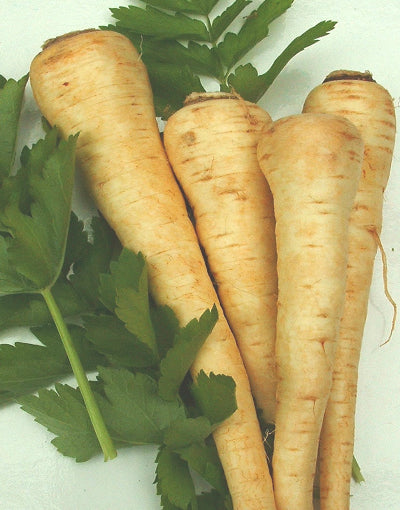How to Grow Parsnip

The essential guide to growing parsnip (Pastinaca sativa) from seed; with notes on germination, cultivation, harvest and even kitchen uses.
Choosing a Variety:
- Most parsnips sold in Australia are long, tapered, white-skinned roots with a nutty sweetness that intensifies after frost.
- All popular cultivars roast, mash and puree beautifully; differences lie mostly in root length and tolerance of heavy soils.
- If your ground is clayey or shallow, look for shorter “stump-rooted” types that are less prone to forking. Forking is also caused by to rich a soil as well.
Seeds per gram: ≈ 400
Feed requirement: Low – rich soils cause hairy, forked roots
Germination Temperature: 10–21 °C (14–28 days; slow, so be patient)
Sowing:
- Prepare a deep bed at least 30 cm, removing stones and clods. Add a thin layer of aged compost and fork through evenly, avoid fresh manure or high-nitrogen fertiliser.
- Mark rows 35–50 cm apart and sow seed 5 mm deep, 5–10 cm apart (or broadcast thinly).
- Keep the surface constantly moist for three weeks. Laying hessian or timber planks over the row helps retain moisture; check daily and remove as soon as first seedlings appear.
- When plants reach 5 cm, thin to 10–12 cm spacing in spring crops or 12–15 cm for late-summer sowings destined for winter harvest.
Growing on:
- Watering: give a deep soak whenever the top 5 cm of soil dries. Uneven moisture causes split roots.
- Feeding: none usually needed after the initial compost. Excess nitrogen = lush tops, small roots.
- Weeding: hand-weed or carefully hoe; parsnip seedlings are easily smothered.
- Clay soils: lighten with coarse sand and extra compost, or grow a stump-rooted variety. Add gypsum to help break up clay soils.
Pests & problems:
- Poor germination: seed older than 18 months loses vigour – buy fresh each season.
- Forked or hairy roots: stones, heavy soil or excess fertiliser; loosen soil thoroughly before sowing.
- Carrot fly & parsnip moth: exclude with insect mesh from sowing to mid-season.
- Bolting: sow after danger of hard frost and avoid midsummer heatwaves; steady watering reduces stress.
- Whitefly & aphids: hose off or use insecticidal soap; encourage lacewings.
Harvest & Storage:
- Parsnips mature 120–140 days from sowing.
- Begin lifting when roots reach usable size; flavour is sweetest after at least one light frost.
- Use a garden fork to loosen soil and pull gently by the tops.
- Late-summer sowings can be left in the ground through winter—hill a little soil or straw over crowns in very cold districts to stop them freezing.
- Trim tops to 2 cm and store roots in a perforated bag in the fridge for up to three weeks, or blanch and freeze for longer keeping.
With loose soil, consistent moisture and a dash of patience, you’ll pull creamy, sweet parsnips all winter—perfect for roasts, soups and mash.
Sowing Periods
| J | F | M | A | M | J | J | A | S | O | N | D | |
|---|---|---|---|---|---|---|---|---|---|---|---|---|
| Cool | ||||||||||||
| Temperate | ||||||||||||
| Sub-Tropical/Tropical |
Filters
3 products
Parsnip ‘Hollow Crown’
Sale priceFrom $3.75
Parsnip ‘Lancer’
Sale priceFrom $3.75
PARSNIP ‘Melbourne Whiteskin’
Sale price$3.75



